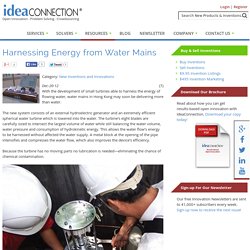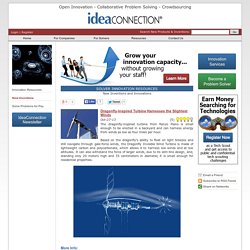

Harnessing Energy from Water Mains. Category: New Inventions and Innovations.

Window Socket Solar-Powered Outlet. Window Socket Solar-Powered Outlet (10)May-16-13 The sleek and intuitive Window Socket concept is a portable, solar powered socket designed to be easily attached to a window.

Meant to be easy to use with no special training, the small, round Window Socket features a solar panel surrounded by a suction plate and a converter that converts the energy to electricity. A battery on the device can store the power for later use, and it can provide up to 10 hours of continuous power when fully charged. More Info: Add Comment Comments We writing in Turkey. We are intresting your Window Socket Solar-Powered Outlet . Best regards Posted by Emre SEVGEN on May 16, 2013 It seems to be interesting Can u please send me complete details for PAKISTAN as i am interested to market it here.
Clip-On Wind Turbine. Clip-On Wind Turbine (4)Aug-04-13 The Colorado-based Cleantec hopes to make wind power more prevalent with the development of their 'clip-on' wind turbine.

The current system consists of a multi-blade drag generator designed to be clipped to the top of existing solar panels. However, the team also believes the small turbine could also be used in other places, such as streetlight, pipelines and rooftops. The turbine blades are twisted slightly, so they can catch the wind at varying angles, the team claims the device can produce a 2000 W output. The project is currently seeking funding on Indiegogo. More Info: Add Comment. Photoflow Harvests the Sun and Water. Photoflow Harvests the Sun and Water (3)Aug-13-13 Taking advantage of both the sun and rain, the Photoflow is a combination rainwater and solar energy harvester.

Most developing countries are located near the equator, where both rain and sunshine are plentiful. The Photoflow, designed by NOS with such countries in mind, features eight triangular solar panels angled to capture rainwater and channel it to a filter and into a water tank. An anti-reflective surface on the solar cells helps to reduce light loss due to reflection while a nano repellent film helps prevent dirt from collecting on the surface of the cells. The water tank itself is lined with a coating to help control bacteria and fungi growth, and each module is fitted with a lid at each end for easy cleaning and maintenance. More Info: Smart Window Blocks Heat, Generates Power. Smart Window Blocks Heat, Generates Power (8)Oct-26-13 A new smart window able to let in light, block heat and generate power could significantly reduce the amount of energy needed to heat, cool and light buildings.

The window was created by a team from Shanghai University, who were hoping to create a transparent window that could also generate power like a solar cell. They succeeded by sandwiching a thin film of vanadium oxide between two layers of polycarbonate. The vanadium oxide will turn metallic at temperatures over 154°F, reflecting infrared light while still allowing the windows to remain transparent. Creating Batteries from Undersea Vents. Creating Batteries from Undersea Vents (2)Oct-27-13 A technology that uses hydrothermal vents on the ocean floor to generate electricity could alleviate one of the challenges of deep-sea exploration.

A collaborative team from the RIKEN Center for Sustainable Resource Science developed the technology—a robotic-assembled system that basically works like a standard battery. Dragonfly-Inspired Turbine Harnesses the Slightest Winds. Dragonfly-Inspired Turbine Harnesses the Slightest Winds (5)Oct-27-13 The dragonfly-inspired turbine from Renzo Piano is small enough to be erected in a backyard and can harness energy from winds as low as four miles per hour.

Based on the dragonfly’s ability to float on light breezes and still navigate through gale-force winds, the Dragonfly Invisible Wind Turbine is made of lightweight carbon and polycarbonate, which allows it to harness low winds and at low altitudes. It can also withstand the force of larger winds, due to its slim-line design, and, standing only 20 meters high and 35 centimeters in diameter, it is small enough for residential properties.
More Info: Add Comment Comments. Wireless Array Harvests Waste Power. Wireless Array Harvests Waste Power (4)Nov-11-13 Researchers have developed a power-harvesting device able to convert stray microwave energy into direct current voltage large enought to recharge a small electronic device.

Created by a team at Duke University, the device is inexpensive to make and operates on principle similar to solar panels. Made of a series of five fiberglass and copper energy conductors wired to a circuit board, the device is able to convert microwaves (such as those from a WiFi hub) into 7.3V of electrical energy. This amount is comparable to that achieved in solar cells. Harnessing Energy from Noise. Harnessing Energy from Noise (5)Dec-09-13 Two separate teams of researchers have been developing a way to use piezoelectric materials to harness the energy in loud sounds, potentially leading to quieter engines and new ways to harness wind power.

Stephen Horowitz, a research engineer based in Hunstville, has been working on sound-energy harnessing technology for the past decade. Generating Power from Changes in Humidity. Generating Power from Changes in Humidity (4)Jan-29-14 Water evaporation could be the largest power source in nature, as has been demonstrated by a prototype electrical generator that moves in response to changes in humidity.

Developed by Ozgur Sahin, Ph.D, the generator features flexible planks covered with spores of the soil bacterium Bacillus subtilis. This bacteria will become tough and wrinkled when dried, but return to its original form almost immediately after being exposed to water. Seafloor Carpet Harnesses Wave Energy. Seafloor Carpet Harnesses Wave Energy (8)Feb-24-14 Inspired by the way a muddy seabed can absorb ocean waves, the seafloor carpet system offers a new way to harness the power of waves for use as an alternative power source. Developed by a team from UC Berkeley, the seafloor carpet is made up of rubber mat placed on top of a grid of hydraulic actuators, cylinders and tubes. The carpet moves up and down with the waves, creating hydraulic pressure that is piped back to shore to be converted into power. The carpet is able to absorb more than 90 percent of the wave energy, and the team believes that 10.8 square feet of the carpet would create enough electricity for two U.S. homes.
Triboelectric Generators Capture the Power of Friction. Triboelectric Generators Capture the Power of Friction (6)Mar-05-14 Researchers have created a simple prototype device able to harvest the energy created start-and-stop motions, such as rain drops, wind or human motions. Professor Zhong Lin Wang of the Georgia Institute of Technology is leading the team of researchers as they create power generators that take advantage of the triboelectric effect—the term for the electricity created when two objects rub against one another and exchange electrons. The prototype generator features two circular sheets of metal that are brought into contact through rotary movements. Electrons flow between the sheets when they make contact, and separating the sheets causes one to hold an electrical charge that is isolated by the gap between them. DualWing Generator Harvests Wind Energy with Wings. DualWing Generator Harvests Wind Energy with Wings (2)Apr-03-14 The DualWingGenerator from Festo replaces the conventional rotor blades of wind turbines with a pair of opposing, flapping wings.
Developed as part of the Bionic Learning Network, the DualWingGenerator is made up of a vertical column that supports a bottom and top pair of 'wings' measuring 98.4 inches across. As the wind moves over the wings, the upper and lower pair will move in opposing direction, creating a motion that is translated into rotary motion within the column. This rotary motion is then sent to an integrated electric motor to be turned into electricity. Transparent Film Harvests the Motion of Water. Transparent Film Harvests the Motion of Water (1)Apr-22-14 Energy-generating toilets may not be far away, thanks to a transparent, flexible film able to harness the motion of water and convert it into electrical energy. Youn Sang Kim and his team created the film by adapting a transducer using dielectric materials. Submerging the dielectric materials in water causes a double layer to form around their outside, and variations between that layer and the water will generate an electric charge.
Better Batteries from Waste Heat. Better Batteries from Waste Heat (2)May-31-14 A novel method of transforming waste heat into electricity allows industrial waste heat be incorporated into more efficient batteries. The method takes advantage of the thermogalvanic effect—which describes the way the voltage of rechargeable batteries is dependent upon their temperature. When an uncharged battery is heated with the waste heat, it can be charged at a lower-than normal voltage. Then, once the battery has cooled, its lower temperature will allow it to be discharged at a higher voltage and thus release more energy than was originally used to charge it. This extra energy, which was added in the form of waste heat, increases the battery's efficiency. The waste-energy harvesting system is able to capture very small differences in temperature fairly efficiently, and it is made of common materials that could be manufactured easily into a larger version suitable for industrial use.
More Info: Add Comment Comments. Eco-Friendly Motor Powered by Static Electricity. Harvesting Energy from Changing Temperatures. Atom-Thin Piezoelectric Generator. Wind Tree Replaces Blades with Leaves. Wind Tree Replaces Blades with Leaves. Energy Harvesting Tree from VTT. Award-winning device harvests energy from railway track vibrations. Much of the abundant mechanical energy around us is irregular and oscillatory and can be somewhat difficult to efficiently tap into. World’s most efficient thermoelectric material developed. Approximately 90 percent of the world’s electricity is generated by heat energy. Unfortunately, electricity generation systems operate at around 30 to 40 percent efficiency, meaning around two thirds of the energy input is lost as waste heat. Despite this, the inefficiency of current thermoelectric materials that can convert waste heat to electricity has meant their commercial use has been limited.
Austrian algae biofuel-production technology to debut in Brazil. Austrian company See Algae Technology is going to debut its algae production and harvesting process in a biomass plant in Brazil (Image via Shutterstock) Image Gallery (3 images) The state of Pernambuco in Brazil’s northeast is going to become home to the country’s first algal biomass plant, thanks to an agreement between See Algae Technology (SAT), an Austrian developer of equipment for the commercial production of algae, and JB, one of Brazil’s leading ethanol producers.
The plant will produce algal biomass from natural and genetically modified strains of algae. Chemical reaction eats up CO2 to produce energy ... and other useful stuff. Transmission electron microscopy image of carbon nitride created by the reaction of carbon dioxide and Li3N. New heat-harvesting material made in $40 microwave oven. Researchers have created an efficient new thermoelectric nanomaterial, that could be used to harvest waste heat for conversion into electricity (Image: Rensselaer/Ramanath) Virtually all electrical devices and industrial processes create heat as they operate, which is typically wasted. In the past several years, various thermoelectric technologies have been developed to address that situation, by converting such heat into electricity. The ideal material for the purpose would be one that has a high electrical conductivity, but a low thermal conductivity - that way, it could carry plenty of electricity without losing efficiency through overheating.
Unfortunately, electrical and thermal conductivity usually seem to go hand in hand. 'Thermally activated cooling system' puts waste heat to use.